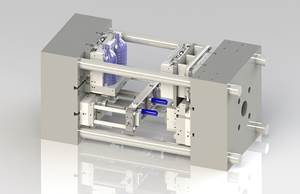Paulson: Fill the Skills Gap…By Training
Training may not be a glitzy as seeing a new machine at a trade show, but the payback is just as real...and it just might help you find and retain employees.
The halls of NPE2018 are buzzing with live demonstrations of primary processing machinery, auxiliary equipment and robots—all designed to make things run more smoothly in your plant and pump up your bottom line. Paulson Training Programs (Booth W5073) has a much quieter display, but it will be just as impactful, the company says. “Training may not be as glamorous as all the shiny new hardware that will be running at the show,” remarks Craig Paulson, the firm’s president. “But the investment is just as good if not better, and the payback is real.”
Craig and his father Don started Paulson Training Programs in 1977. Since then, Craig Paulson estimates it has trained 50,000 people at more than 5000 companies. Training has never been an “easy sell,” but Paulson contends that nowadays—with the skills gap showing no sign of narrowing—more processors are seeing it not only as a tool to make a ┤¾¤¾┤½├¢ more efficient and profitable, but to recruit and retain employees.
“It’s tough getting young people graduating high school interested in pursuing a career in plastics,” he says. “The visibility of our industry is low among young people. Even beyond the high-school level, there are few colleges offering degreed programs in plastics engineering or polymer science. But savvy companies are starting to realize that training can be used as a recruitment and ‘onboarding’ tool. They can more readily demonstrate to young people how they can build a career in plastics and make good money doing it. Some of our customers who are in areas of the country where manufacturing is strong—such as the Midwest, the Carolinas, Texas—are seeing how effective this can be.”
Of course, to be truly impactful, processors must make an ongoing commitment to training or else they’ll run the risk of disillusioning a new hire. Paulson says, “Saying you have ‘a training program’ is not enough. You have to implement it the right way. You need to employ best practices. It’s very important that someone be in charge. If both the training tools and execution are right, you can turn someone who’s been flipping burgers into a competent molder with time. And as a ┤¾¤¾┤½├¢, training can help you create a positive work environment that will help you retain your employees.”
Paulson estimates that about 70% of its training ┤¾¤¾┤½├¢ is in injection molding, but it offers programs in blow molding, extrusion and thermoforming. Training is available online on a subscription basis. For a one-time fee, the company still offers its training programs on DVDs for a one-time charge, which allows users to upload all course data on their servers.
Of late, Paulson is doing more “hands-on” on-site training, running seminars over a 4-5-day period with its injection machinery partners, or directly at facilities of processors for a more customized learning experience—“tailor-made to the customer’s parts, materials, machine and mold,” Paulson explains.
“Training is a viable investment that has a verifiable return,” he states. “It’s a huge headache remover. Too many plant managers spend most of their days putting out fires that result from things done wrong. The results of training can be measured in terms of reducing scrap, increasing machinery uptime, improving production by decreasing cycles. We had one customer molding bumpers decrease cycle time from 90 sec to 45 sec. as a result of modifications that they made to their process based on what they learned in our training program. Then—and this of course is tough to measure—there are savings you realize by not making mistakes in the first place.”
Related Content
At NPE, Cypet to Show Latest Achievements in Large PET Containers
Maker of one-stage ISBM machines will show off new sizes and styles of handled and stackable PET containers, including novel interlocking products.
Read MoreA Purge Solution for the Blow Molding and Compounding Industries
New commercial purge compounds for new industries from Chem-Trend.
Read MoreBlow Molder with a Mission: CKS Packaging Shares Gains Of Its Phenomenal Growth
From three machines in 1986 to 27 plants nationwide today, this family-owned processor has prospered through unwavering customer service, committed employees and dedicated service to its community.
Read MoreMultilayer Solutions to Challenges in Blow Molding with PCR
For extrusion blow molders, challenges of price and availability of postconsumer recycled resins can be addressed with a variety of multilayer technologies, which also offer solutions to issues with color, processability, mechanical properties and chemical migration in PCR materials.
Read MoreRead Next
For PLASTICS' CEO Seaholm, NPE to Shine Light on Sustainability Successes
With advocacy, communication and sustainability as three main pillars, Seaholm leads a trade association to NPE that ‘is more active today than we have ever been.’
Read MoreLead the Conversation, Change the Conversation
Coverage of single-use plastics can be both misleading and demoralizing. Here are 10 tips for changing the perception of the plastics industry at your company and in your community.
Read MoreSee Recyclers Close the Loop on Trade Show Production Scrap at NPE2024
A collaboration between show organizer PLASTICS, recycler CPR and size reduction experts WEIMA and Conair recovered and recycled all production scrap at NPE2024.
Read More













